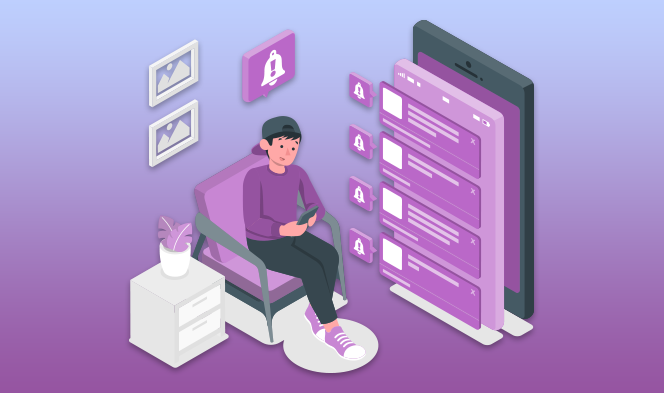1298
Push Notifications: Introduction, Benefits, & Best Strategies
05 Mar, 2021
6 min read
1298
05 Mar, 2021
6 min read

14th February was just another day for singles like me. I was strolling in my verandah, watching YouTube videos, and enjoying the gentle breeze. Just then, a notification popped up on my phone – “V-Day Sale ends tonight. Learn for as low as $10.”, and I was hooked. I opened the Udemy app and ended up buying two new courses on Valentine’s Day. Quite a hook-up with my new partners – the courses on V-Day!
Well, that’s just one example out of countless examples to prove the potential of push notifications. If you don’t know what push notifications are, how they help, and the best strategies to create them, you’ll learn it all by the end of this post.
We can attribute the rise of modern-day push notifications to BlackBerry. Blackberry was the first company to introduce push email to free users from manually checking for emails every time. The users could view the push emails on the screen, delete them, or respond to them instantly. And that’s how Blackberry got a strong foothold among business users.
Then came the year 2009 when Apple launched the push notification service with iOS 3.0. Push notifications stayed mobile-only until 2015 when Google introduced push notifications through a web browser (Chrome). Fast forward to 2021, and there are hardly any companies that don’t use push notifications in their apps.
A push notification is a pop-up message that appears on a device’s screen even when you are not using the app. It helps engage your customers at the right time with the right message and increase sales and profitability.
Want help integrating push notifications in your app?
Integrating push notifications can be the right choice for both iOS and Android app development.
The only catch is that these push notifications should be well-timed, well-thought, and valuable. Or else they may sometimes backfire due to the distraction that they cause for the users.
Here are the few best practices that you can follow to make the most of push notifications.
Don’t go for including any information you like in push notifications. Never do that, as it may do more harm than good and lead to app uninstallations.
While 55% to 60% of app users agree to receive push notifications, 52% seek relevant information and offers via push notifications.
So, concentrate and include only what they would like to see in your push notifications. Don’t go overboard with all kinds of information about your company that users don’t require. Put yourself in your users’ shoes and see what you would like to view.
The second factor that you must take care of is creativity. Only creative push notifications can help you stand out from the stuffed notification tray. There are two aspects that you need to cover for a creative notification – copy and design.
The copy refers to the text content of your notification while the design refers to the image that accompanies the copy. Both copy and design should complement each other to get a creative notification.
The four factors that you can take care of while creating push notifications – Intrigue, Decisiveness, Simplicity, and Alignment.
Establishing a balance between all these factors can help make your notifications engaging.
Taking due care of the character limit of the message is also crucial. If you are thinking of Android app development; the character limit that Android allows is somewhere between 450-600. For iOS, the default limit is comparatively less and lies somewhere between 150-230.
But it doesn’t mean that you can stuff your messages!
Instead, limit the characters to 40 or 50 but keep the message clear, crisp, and to-the-point. It has been a common observation that succinct and target messages of short lengths attract users more than long-drawn messages.
So, make it short – but worth opening.
Consider two messages:
Message 1 – Save up to 40% on jeans and sweaters. Order now!
Message 2 – 3-day sale on jeans and sweaters
Which one would you think can engage users more easily?
Well, for some – it may be the word “Sale”, but for most of the others – it is the figure of 40 that counts.
While both copies serve the purpose in a way, the first message conveys it in a more compelling language. It drives a sudden action from the user as they see how much they can save straight away.
So, that’s the power of compelling and action-driven words. They just make it too irresistible for the user not to open the notification.
So, choose the words – wisely and smartly to make a copy your users can’t resist.
Action buttons in push notifications help the user do a lot more with your app. You can expand the scope of users’ actions with CTAs. Users can book a service, order an item, or read a blog on your page, etc. with CTAs.
The right CTA in the push notification helps:
Excess of anything is bad. Users should receive push notifications but only those that are actually useful. Constantly nudging the user with too many and ill-timed notifications can backfire. Your notifications can turn into spams on the notification tray – or even worse – can lead to app uninstalls.
Two ways you can avoid overdoing it are as follows:
If you want your user to take an action fast, use the power of deep-linking. Deep linking means redirect users to a specific page on the app using engaging links. Incorporating deep linking in push notifications will help in two ways.
First, the user will land on exactly the page of the app you want them to take them to for the action.
Second, it will be direct and time-saving for the user as they don’t have to browse your app to acquire the information.
Reminders and back-in-store alerts are the two types of push notifications that can help a lot.
If you have good traffic on your website and app, but cart abandonment is your main issue, send out reminder notifications. You can also try offering an incentive related to the purchase to bring back the user to your app.
In other cases, users leave your app because the product they want is out of stock. In that case, to re-engage the user and bring them back, back-in-store alerts can save your day. They can just grab the attention of subscribers in real-time and prompt them to take the action. In such cases, including a CTA in the push notification can be even more better to drive a quick purchase.
Using location-based alerts personalizes users’ experience further. If you also have a physical store, location-based alerts can be icing on the cake for your business. They won’t only boost your online traffic but also help increase foot traffic in your store.
For example, if you decide to run a 4-day sale at your store, you can alert users about that sale. The users will want to visit your company’s store in their vicinity and boost your revenue offline too. You can also used push notifications that are triggered based on location, so anyone who comes within a specified radius of the store, gets an alert on their phone.
Push notifications are a great means to prompt actions from your customers. With the right strategies, your sales and revenue can skyrocket.
If you are new to e-commerce and don’t know where to start, we can help you out. We can discuss your requirements, analyze them, and build the right app for your business. We can also integrate push notifications and other functionalities as per your requirements in that. Our marketing experts can also guide you through tips to promote and monetize your app efficiently.
All product and company names are trademarks™, registered® or copyright© trademarks of their respective holders. Use of them does not imply any affiliation with or endorsement by them.

68
By Biztech
09 Oct, 2025

75
By Biztech
09 Oct, 2025

91
By Biztech
06 Oct, 2025